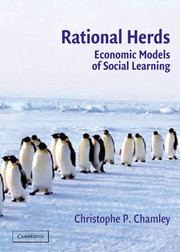Book contents
- Frontmatter
- Contents
- Preface
- 1 Introduction
- PART ONE Social Learning
- 2 Bayesian Tools
- 3 Social Learning with a Common Memory
- 4 Cascades and Herds
- 5 Limited Memories
- 6 Delays
- 7 More Delays
- 8 Outcomes
- 9 Networks and Diffusion
- 10 Words
- PART TWO Coordination
- PART THREE Financial Herding
- References
- Author Index
- Subject Index
9 - Networks and Diffusion
Published online by Cambridge University Press: 12 January 2010
- Frontmatter
- Contents
- Preface
- 1 Introduction
- PART ONE Social Learning
- 2 Bayesian Tools
- 3 Social Learning with a Common Memory
- 4 Cascades and Herds
- 5 Limited Memories
- 6 Delays
- 7 More Delays
- 8 Outcomes
- 9 Networks and Diffusion
- 10 Words
- PART TWO Coordination
- PART THREE Financial Herding
- References
- Author Index
- Subject Index
Summary
It is not what you know, but whom you know.
In the diffusion of a new technology, agents learn from the output of others new techniques or how to use the techniques. Some applications in the adoption of high-yield variety crops are discussed. The theoretical analysis of learning in networks is introduced.
Sociologists were the first to publish empirical studies on the spatial or intertemporal diffusion of innovations, and they began early. In 1897, Durkheim presented maps of suicide frequencies by district in France and Germany to refute the contagion hypothesis of Tarde (Chapter 1). Sociologists are interested in the diffusions of innovations as “social changes.”
The agricultural context offers many examples of learning from others with the gradual adoption of new crops and new techniques. The short study by Ryan and Gross (1943) has been pathbreaking in rural sociology, which has become a field of investigation in itself. Ryan and Gross interviewed 259 farmers in Iowa where hybrid corn was first introduced in the thirties, and focused on the time profile of diffusion. Their results are descriptive: (i) the time profile of the share of hybrid corn in the total corn acreage follows a curve that is similar to the cumulative distribution function of a normal distribution (with some skewness toward the first year of introduction); this profile of adoption has therefore an S-shape (as illustrated in Figure 9.1, from another study by Griliches (1957)); (ii) farmers learned about hybrid corn from salespeople; (iii) during a first phase of the diffusion (three years), 50 percent of the farmers were convinced by salesmen and about 20 percent by neighbors; after this phase, the proportions are reversed.
- Type
- Chapter
- Information
- Rational HerdsEconomic Models of Social Learning, pp. 193 - 210Publisher: Cambridge University PressPrint publication year: 2003



